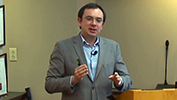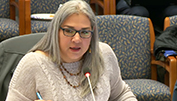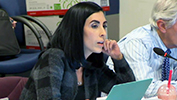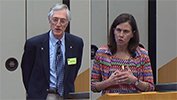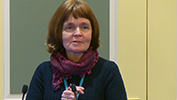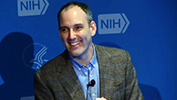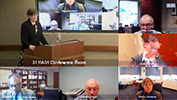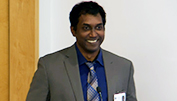-
- NIH VideoCast - COPD & Rural Health: A Dialogue on the National Action Plan
-
- - National Heart, Lung, and Blood Institute, NIH (2018/03/23)
- - Category : Conferences
- Chronic obstructive pulmonary disease, COPD, is a leading cause of death in the United States, with more than 150,000 deaths annually. Nationwide millions are affected by the disease, which imposes an enormous burden on individuals with COPD, their caregivers, and the nation???s health care system, especially in rural communities.
The COPD National Action Plan, the first-ever blueprint for a multi-faceted, unified fight against the disease, provides a comprehensive framework for action by those affected by the disease and those who care about reducing its burden. This one-day, in-person meeting will bring together rural health and COPD experts to further the dialogue on how to address the goals and objectives of the COPD National Action Plan from a rural perspective and move toward its implementation by identifying challenges, opportunities, and resources; exploring solutions; sharing best practices; and fostering collaboration. A report will be developed and a webinar will be held later in the summer to summarize key findings from the meeting that can be referenced as organizations move toward implementation of the National Action Plan in rural communities.
NIH VideoCast - COPD & Rural Health: A Dialogue on the National Action Plan
-
- NIH VideoCast - The Promise and Pitfalls of HIV Treatment-as-Prevention: Quasi-Experimental Evidence from South Africa
-
- - Dr. Jacob Bor, Boston University (2018/03/21)
- - Category : Special
- 2018 ODP Early-Stage Investigator Lecture Sponsored by the NIH Office of Disease Prevention
The Office of Disease Prevention (ODP) is pleased to announce Dr. Jacob Bor as the winner of the ODP Early-Stage Investigator Lecture. Dr. Bor is an Assistant Professor and Peter T. Paul Career Development Professor in the Departments of Global Health and Epidemiology at Boston University School of Public Health. His presentation is titled: ???The Promise and Pitfalls of HIV Treatment-as-Prevention: Quasi-Experimental Evidence from South Africa.???
Dr. Bor???s research applies the analytical tools of economics and data science to the study of population health, with a focus on HIV treatment and prevention in southern Africa. Current research interests include chronic disease management in low-resource settings; economic spillover effects of HIV treatment; decision-making in HIV-endemic risk environments; population health impacts of social policy; and causal inference in public health research. His work has been published in Science, The Lancet, PLOS Medicine, Epidemiology, and Health Affairs.
The ODP Early-Stage Investigator Lecture recognizes early-career prevention scientists who have not yet competed successfully for a substantial NIH-supported research project, but who have already made substantial, outstanding research contributions to their respective fields and are poised to become future leaders in prevention research.
NIH VideoCast - The Promise and Pitfalls of HIV Treatment-as-Prevention: Quasi-Experimental Evidence from South Africa
-
- NIH VideoCast - Precise genome-wide mapping of single nucleosomes and linkers in vivo
-
- - R??zvan V. Chereji, Ph.D., NICHD, NIH (2018/03/21)
- - Category : Special
- Biowulf Seminar Series
We developed a chemical cleavage method that allows us to precisely map both single nucleosomes and linkers with very high accuracy genome-wide in budding yeast. We confirm that /S. cerevisiae/ promoters are sites of strong nucleosome depletion, but attribute the putative nucleosome depletion seen at termination sites to MNase bias. Our nucleosome mapping data has the highest resolution among the currently available techniques, and this accuracy allows us to distinguish alternative rotational positions that nucleosomes occupy in different cells. Furthermore, we show that linker DNA has quantized lengths for individual genes. By comparing our nucleosome dyad positioning maps to existing genomic and transcriptomic data, we evaluate the contributions of sequence, transcription, histone H1 and the H2A.Z variant in defining the chromatin landscape. We show that DNA sequence has a very limited effect on establishing the nucleosome organization as observed /in vivo/. Moreover, we find that the degree of gene compaction, measured by the spacing between neighboring nucleosomes, correlates with the transcription level, amount of histone H1 bound to the gene, and the amount of H2A.Z variant that is incorporated in the nucleosomes closest to the gene promoter (???+1 nucleosomes???). Furthermore, we present a biophysical model based on simple physical principles, which shows that steric exclusion between neighboring nucleosomes suffices to explain the salient features of nucleosome positioning and the complex nucleosome phasing pattern that is observed near the gene ends.
For more information go to https://hpc.nih.gov
NIH VideoCast - Precise genome-wide mapping of single nucleosomes and linkers in vivo
-
- NIH VideoCast - The Science of Patient-Centered Research: Enhancing Our Understanding of the Impact of Cancer and Its Treatment
-
- - Terri S. Armstrong, Ph.D., FAAN, Senior Investigator, Neuro-Oncology Branch, Center for Cancer Research, NCI, NIH (2018/03/20)
- - Category : Special
- NCI???s Center for Cancer Research (CCR) Grand Rounds
Terri S. Armstrong is a Senior Investigator in the Neuro-Oncology Branch (NOB), Center for Cancer Research (CCR), National Cancer Institute (NCI), National Institutes of Health (NIH). Her program of research focuses on clinical outcomes assessment in clinical trials, exploring the biologic basis of symptoms and toxicity and developing prediction modeling and biologically based interventions for symptom management.
Dr. Armstrong obtained her master`s in oncology from the Ohio State University and her Ph.D. from the University of Texas Health Science Center. She has worked in the field of neuro-oncology since 1992 and has held faculty positions at Emory University, M.D. Anderson Cancer Center, and the University of Texas Health Science Center School of Nursing, where she held the school???s prestigious Dunn Distinguished Professorship in Oncology Nursing. Dr. Armstrong has maintained a clinical practice in neuro-oncology as well as research faculty positions with a focus on clinical outcomes assessment and exploring clinical and biologic predictors of toxicity and symptoms. She has received numerous research grants from philanthropy, professional associations, and was awarded an NIH R01 grant for developing prediction models of toxicity. Dr. Armstrong has published 100 manuscripts in peer-reviewed journals and over 15 book chapters on the care of patients with central nervous system tumors in addition to presenting on a regional, national and international level. She is currently Vice President of the Society for Neuro-Oncology and is the Quality of Life representative and chair on several studies in cooperative groups including Alliance Oncology and the NRG Oncology Research Group.
NIH VideoCast - The Science of Patient-Centered Research: Enhancing Our Understanding of the Impact of Cancer and Its Treatment
-
- NIH VideoCast - NIH Tribal Advisory Committee Meeting - March 2018 (Day 2)
-
- - NIH (2018/03/20)
- - Category : Advisory Board Meetings and Workshops
- The TAC is advisory to the NIH, and provides a forum for meetings between elected Tribal officials (or their designated representatives) and NIH officials to exchange views, share information, and seek advice concerning intergovernmental responsibilities related to the implementation and administration of NIH programs. (See our charter for more information.) It was established to help ensure that Tribes and AI/AN people have meaningful and timely input in the development of NIH policies, programs, and priorities. The NIH TAC seeks to ensure that NIH policies or activities that affect AI/AN communities are brought to the attention of Tribal leaders.
The NIH TAC charter calls for representation from each of the 12 geographic areas served by the Indian Health Service (IHS) including Alaska, Albuquerque, Bemidji, Billings, California, Great Plains, Nashville, Navajo, Oklahoma, Phoenix, Portland, and Tucson. In addition, the NIH TAC charter calls for one representative (and a designated alternate) for each of five National at-large Tribal member positions. The NIH TAC met for the first time on September 29-30, 2015.
NIH VideoCast - NIH Tribal Advisory Committee Meeting - March 2018 (Day 2)
-
- NIH VideoCast - The Neurobiology of Vocal Learning and Spoken Language
-
- - Erich Jarvis, Ph.D., Rockefeller University (2018/03/20)
- - Category : Neuroscience
- NIH Neuroscience Series Seminar
Dr. Jarvis lab is investigating the genes and molecular mechanisms underlying neural circuits related to learned vocal communication. Understanding the nervous system???s anatomical and functional pathways for information processing is critical to explaining complex behaviors such as singing and speaking. By unraveling aspects of vocal learning in birds and mammals, Dr. Jarvis and his team hope to shed light on speech disorders in humans and help restore some voices silenced by disability or disease.
For more information go to https://neuroscience.nih.gov/neuroseries/Home.aspx
NIH VideoCast - The Neurobiology of Vocal Learning and Spoken Language
-
- NIH VideoCast - Secretary???s Advisory Committee on Human Research Protections (SACHRP) - March 2018 (Day 1)
-
- - HHS (2018/03/17)
- - Category : Secretary`s Advisory Committees
- SACHRP provides expert advice and recommendations to the Secretary, through the Assistant Secretary for Health, on issues and topics pertaining to or associated with the protection of human research subjects. The committee is composed of 11 appointed voting members, with additional ex-officio members from Common Rule government agencies. SACHRP presently has two working subcommittees, the Subpart A Subcommittee (SAS) and the Subcommittee on Harmonization (SOH). The March 13, 2018 meeting will include the following topics: an overview of secondary use of biospecimens and data; FAQs on the use of biospecimens, repositories and informed consent under the new and revised Common Rule; FAQs on the use of broad consent; recommendations regarding exceptions to the use of a single IRB; and the impact of the European Union???s General Data Protection Regulation on HHS human subjects research. Time is allotted for public comment.
NIH VideoCast - Secretary???s Advisory Committee on Human Research Protections (SACHRP) - March 2018 (Day 1)
-
- NIH VideoCast - NIH Tribal Advisory Committee Meeting - March 2018 (Day 1)
-
- - NIH (2018/03/17)
- - Category : Advisory Board Meetings and Workshops
- The TAC is advisory to the NIH, and provides a forum for meetings between elected Tribal officials (or their designated representatives) and NIH officials to exchange views, share information, and seek advice concerning intergovernmental responsibilities related to the implementation and administration of NIH programs. (See our charter for more information.) It was established to help ensure that Tribes and AI/AN people have meaningful and timely input in the development of NIH policies, programs, and priorities. The NIH TAC seeks to ensure that NIH policies or activities that affect AI/AN communities are brought to the attention of Tribal leaders.
The NIH TAC charter calls for representation from each of the 12 geographic areas served by the Indian Health Service (IHS) including Alaska, Albuquerque, Bemidji, Billings, California, Great Plains, Nashville, Navajo, Oklahoma, Phoenix, Portland, and Tucson. In addition, the NIH TAC charter calls for one representative (and a designated alternate) for each of five National at-large Tribal member positions. The NIH TAC met for the first time on September 29-30, 2015.
NIH VideoCast - NIH Tribal Advisory Committee Meeting - March 2018 (Day 1)
-
- NIH VideoCast - Secretary???s Advisory Committee on Human Research Protections (SACHRP) - March 2018 (Day 2)
-
- - HHS (2018/03/17)
- - Category : Secretary`s Advisory Committees
- SACHRP provides expert advice and recommendations to the Secretary, through the Assistant Secretary for Health, on issues and topics pertaining to or associated with the protection of human research subjects. The committee is composed of 11 appointed voting members, with additional ex-officio members from Common Rule government agencies. SACHRP presently has two working subcommittees, the Subpart A Subcommittee (SAS) and the Subcommittee on Harmonization (SOH). The March 14, 2018 meeting will be largely devoted to a discussion of ???key information in informed consent under the revised Common Rule, and includes the following: a regulatory overview of ???key information??? in informed consent under the revised Common Rule; new insights on the interpretation of ???key information??? from an expert panel; discussion of subcommittee recommendations on ???key information???; remarks from patient advocates regarding the interpretation of ???key information???. Time is allotted for public comment.
NIH VideoCast - Secretary???s Advisory Committee on Human Research Protections (SACHRP) - March 2018 (Day 2)
-
- NIH VideoCast - Valuing Their Voice: Creating an Infrastructure to Support Patient-Centered and Community Engaged Research
-
- - Giselle Corbie-Smith, M.D., M.Sc., University of North Carolina School of Medicine (2018/03/16)
- - Category : Special
- The National Institute on Minority Health and Health Disparities Director???s Seminar Series
The National Institute on Minority Health and Health Disparities (NIMHD) welcomes Giselle Corbie-Smith, M.D., M.Sc. as the NIMHD Director???s Seminar Series (DSS) speaker. Her presentation ???Valuing Their Voice: Creating an Infrastructure to Support Patient-Centered and Community Engaged Research??? will:
-Define the relationship between patient-centered and community engaged research.
-Describe a research infrastructure to support engaged scholarship.
-Demonstrate the role of an institutional approach to engaged scholarship.
Dr. Corbie-Smith is the Kenan Distinguished Professor of Social Medicine and Medicine at the School of Medicine, University of North Carolina (UNC) Chapel Hill. Dr. Corbie-Smith is nationally recognized for her scholarly work on the practical and ethical issues regarding involvement of minorities in research. She directs the Program on Health Disparities at the Cecil G. Sheps Center for Health Services Research at UNC-Chapel Hill and has been a member of several national and regional committees including National Academies of Sciences committees examining the ethical issues of involving minority communities and underserved groups in housing-related research and on standards for systematic reviews in comparative effective research.
NIH VideoCast - Valuing Their Voice: Creating an Infrastructure to Support Patient-Centered and Community Engaged Research
-
- NIH VideoCast - CC Grand Rounds: Contemporary Clinical Medicine: Great Teachers: Clinical Research in Vasculitis: A Model for Studying Rare Diseases
-
- - Peter A. Merkel, MD, MPH, Chief, Division of Rheumatology; Professor of Medicine and Epidemiology, University of Pennsylvania (2018/03/16)
- - Category : Clinical Center Grand Rounds
- CC Grand Rounds: Contemporary Clinical Medicine: Great Teachers: Clinical Research in Vasculitis: A Model for Studying Rare Diseases
For more information go to http://www.cc.nih.gov/about/news/grcurrent.html
NIH VideoCast - CC Grand Rounds: Contemporary Clinical Medicine: Great Teachers: Clinical Research in Vasculitis: A Model for Studying Rare Diseases
-
- NIH VideoCast - Gut reactions: host microbiome interactions in the intestine in health and disease
-
- - Fiona Powrie, D. Phil., Professor; Director, Kennedy Institute of Rheumatology, University of Oxford (2018/03/16)
- - Category : WALS - Wednesday Afternoon Lectures
- NIH Director`s Wednesday Afternoon Lecture Series
The gastrointestinal tract is home to a large number and vast array of bacteria that play an important role in nutrition, immune-system development, and host defense. In inflammatory bowel disease there is a breakdown in this mutualistic relationship resulting in aberrant inflammatory responses to intestinal bacteria. Studies in model systems indicate that intestinal homeostasis is an active process involving a delicate balance between effector and immune suppressive pathways. For her presentation, Dr. Powrie will discuss bacterial pathways that promote intestinal homeostasis and host defense, and how these may be harnessed therapeutically.
For more information go to https://oir.nih.gov/wals/2017-2018/
NIH VideoCast - Gut reactions: host microbiome interactions in the intestine in health and disease
-
- NIH VideoCast - Resolution of Inflammation
-
- - Arjana Rao, PhD, Professor and Division Head, Division of Signaling and Gene Expression, La Jolla Institute For Allergy and Immunology (2018/03/16)
- - Category : Immunology
- Immunonology IG Seminar
Dr Rao???s research has been focused on understanding how signaling pathways control gene expression, using T cells and other cells of the immune system as models. Her laboratory has been particularly interested in a pathway of gene expression that is regulated by calcium influx into many different types of cells: it involves a process known as store-operated calcium entry, which activates a phosphatase, calcineurin, which dephosphorylates and sends a transcription factor, NFAT, to the nucleus. NFAT turns on a large number of genes, in a manner appropriate to the cell type and mode of stimulation; in T cells, it controls both the positive transcriptional programmes of T cell activation and negative programmes known as anergy or exhaustion that attenuate T cell activation. Her laboratory is using RNA interference and CRISPR/Cas9 screens, mice with targeted gene disruption, high-throughput sequencing and other technologies to analyze how genes are regulated and how loss of function of certain proteins leads to diseases such as autoimmunity, immune deficiencies, developmental defects and cancer. A current important focus involves the TET family of 5-methylcytosine oxidases, which control cell lineage specification in many different systems. Profound TET loss-of-function is associated with aggressive cancers, both in human and in mouse model systems, and Dr Rao???s laboratory is examining the mechanisms involved.
NIH VideoCast - Resolution of Inflammation
-
- NIH VideoCast - Diet and Cancer Prevention: Chewing on the Human Complexities
-
- - Johanna W. Lample, PhD, RD, Research Professor, University of Washington, Full Member and Associate Division Director, Cancer Prevention Program, Public Health Sciences Division, Fred Hutchinson Cancer Research Center, Seattle, WA (2018/03/15)
- - Category : Stars in Nutrition
- Stars in Nutrition and Cancer
The aim of the lecture is to: outline mechanisms by which dietary consituents in plant foods lower cancer risk; describe the application of controlled feeding studies in humans to cancer prevention research; and describe the impact of host and microbial genotypes on response to diet and implications for prevention.
Dr. Lampe is a full member and Associate Division Director in the Public Health Sciences Division at Fred Hutchinson Cancer Research Center. She also is a research professor in the Department of Epidemiology at the University of Washington in Seattle.
For more information go to https://prevention.cancer.gov/research-groups/nutritional-science/about-nutritional-science/stars-nutrition-and-cancer
NIH VideoCast - Diet and Cancer Prevention: Chewing on the Human Complexities
-
- NIH VideoCast - 2018 Demystifying Medicine: Brave New World: Imaging from the Cosmos to the Molecule
-
- - John Mather, PhD, Nobel Prize in Physics, National Aeronautics and Space Administration (NASA) and Jennifer Lippincott-Schwartz, PhD, MS, HHMI, Janelia Research Campus (2018/03/15)
- - Category : Demystifying Medicine
- Demystifying Medicine Lecture Series
John Mather is the co-recipient of the 2006 Nobel Prize in Physics for his work in detecting the remnant radiation from the birth of the universe, called the cosmic microwave background, which strongly supported the "big bang" theory and which physicist Stephen Hawking described as "the most important discovery of the century, if not of all time." Mather now is project scientist for the James Webb Space Telescope (JWST), the planned successor to the Hubble Space Telescope.
Lippincott-Schwartz was chief of the NICHD Section on Organelle Biology before moving to the Janelia Research Campus in 2016. Her NIH lab hosted and provided the biological materials to Eric Betzig, who worked with Lippincott-Schwartz, George Patterson (now at NIBIB) and others to develop photoactivation localization microscopy (PALM), which ultimately earned Betzig the 2014 Nobel Prize in Chemistry.
The Demystifying Medicine Lecture Series is designed to help bridge the gap between advances in biology and their applications to major human diseases. The lectures include presentations of patients, pathology, diagnosis, and therapy in the context of major diseases and current research. All clinicians, trainees including fellows, medical students, Ph.D. students, and other healthcare and research professionals are welcome to attend.
For more information go to https://demystifyingmedicine.od.nih.gov
NIH VideoCast - 2018 Demystifying Medicine: Brave New World: Imaging from the Cosmos to the Molecule
-
- NIH VideoCast - From Germline Genetics to Function: Making Sense of Genome-Wide Association Studies for Pancreatic Cancer Risk
-
- - Laufey Amundadottir, Ph.D., Senior Investigator, Laboratory of Translational Genomics, NCI, NIH (2018/03/13)
- - Category : NIH Director`s Seminars
- NIH Directors Seminar Series
Pancreatic ductal adenocarcinoma (PDAC) is the third leading cause of cancer-related deaths in the United States and the seventh world-wide. This seminar will discuss results from genome-wide association studies (GWAS), conducted within the NCI-led Pancreatic Cancer Cohort Consortium. This collaborative effort has identified over 20 common pancreatic cancer risk loci. Genomic and functional characterization of a subset of these loci will be presented. These examples highlight different molecular mechanisms underlying cancer risk and genes found to be important for a wide range of processes including telomere maintenance, RNA surveillance and pancreatic development and homeostasis.
NIH VideoCast - From Germline Genetics to Function: Making Sense of Genome-Wide Association Studies for Pancreatic Cancer Risk
-
- NIH VideoCast - Under Your Skin: Molecules and Cells for Touch and Pain
-
- - Alexander Chesler, Ph.D., Principal Investigator, Section on Sensory Cells and Circuits Intramural Lab, National Center for Complementary and Integrative Health, NIH (2018/03/13)
- - Category : National Center for Complementary and Integrative Health
- The National Center for Complementary and Integrative Health (NCCIH) presents the integrative Medicine Research Lecture Series. The series provides overviews of the current state of research and practice involving complementary health approaches and explores perspectives on the emerging discipline of integrative medicine. Dr. Alexander Chesler, Ph.D., Principal Investigator, Section on Sensory Cells and Circuits Intramural Lab, NCCIH, is our guest speaker for this lecture.
The somatosensory system enables us to detect touch, temperature and painful stimuli. By studying patients with a rare, inherited disease, Alexander Chesler, Ph.D., and his team identified a key molecule for detecting touch and proprioception, our body???s awareness of itself in space. In this lecture, Dr. Chesler will discuss the ???sixth sense??? and how recent advances in genetics and functional imaging in model systems can help shed light on mechanisms involved in acute and chronic pain.
For more information go to https://nccih.nih.gov/news/events/IMlectures
NIH VideoCast - Under Your Skin: Molecules and Cells for Touch and Pain
-
- NIH VideoCast - Building Cortical Networks: from Molecules to Function
-
- - Beatriz Rico, Ph.D., Kings College (2018/03/13)
- - Category : Neuroscience
- NIH Neuroscience Series Seminar
Dr. Rico???s lab research seeks to understand how the brain is built and how deviations from the normal plan impact behavior and cause disease. Without this knowledge, we can only hope that chance will lead us to new therapies for neurological and psychiatric disorders, which affect the lives of hundreds of millions of people worldwide.
Their research encompasses neural stem cell manipulation, generation of brain organoids, structural and functional in vivo imaging, optogenetic manipulation of neural circuits, and mathematical and systems biology approaches to circuit assembly and function. Ongoing collaborations between basic and clinical researchers also allow the study of neurons derived from human patients with neurodevelopmental disorders. They take advantage of a large range of experimental approaches and model organisms, from worms to humans. The outstanding collaborative culture established here facilitates rapid progress through the synergistic effort of scientists with very diverse backgrounds and complementary skills.
For more information go to https://neuroscience.nih.gov/neuroseries/Home.aspx
NIH VideoCast - Building Cortical Networks: from Molecules to Function
-
- NIH VideoCast - NCI Clinical Trials and Translational Research Advisory Committee (CTAC) - March 2018
-
- - Coordinating Center for Clinical Trials, NCI, NIH (2018/03/09)
- - Category : Clinical Trials and Translational Research
- The CTAC makes recommendations on the NCI-supported national clinical trials enterprise to build a strong scientific infrastructure by bringing together a broadly developed and engaged coalition of stakeholders involved in the clinical trial process
For more information go to http://deainfo.nci.nih.gov/advisory/ctac/ctacmeetings.htm
NIH VideoCast - NCI Clinical Trials and Translational Research Advisory Committee (CTAC) - March 2018
-
- NIH VideoCast - Translating from Chemistry to Clinic with Deep Learning
-
- - S. Joshua Swamidass, MD, PhD, Assistant Professor, Laboratory and Genomic Medicine, Washington University School of Medicine (2018/03/09)
- - Category : Special
- NLM Informatics and Data Science Lecture Series
Many medicines become toxic only after bioactivation by metabolizing enzymes. Often, metabolic enzymes transformed them into chemically reactive species, which subsequently conjugate to proteins and cause adverse events. For example, carbamazepine is epoxidized by P450 enzymes in the liver, but then conjugates to proteins, causing Stevens Johnson Syndrome in some patients. The most difficult to predict drug reactions, idiosyncratic adverse drug reactions, often depend on bioactivation. Our group has been using deep learning to model the metabolism of diverse chemicals, and the subsequent reactivity of their metabolites. Deep learning systematically summarizes the information from thousands of publications into quantitative models of bioactivation, predicting exactly how medicines are modified by metabolic enzymes. These models are giving deeper understanding of why some drugs become toxic, and others do not. At the same time, deep learning can be used to understand drug toxicity as it arises in clinical data, and why some patients are affected, but not others. A conversation between the basic and clinical sciences is now possible, where patient outcomes can be understood in light of bioactivation mechanisms, and these mechanisms can explain why some patients are susceptible to drug toxicity, and others are not.
S. Joshua Swamidass is an Assistant Professor of Laboratory and Genomic Medicine at Washington University School of Medicine (http://swami.wustl.edu). His group studies information with new computational methods, at the intersection of biology, medicine and chemistry. He is funded by the National Library Medicine (NLM) to model bioactivation pathways, and how bioactivation pathways change in children. Dr. Swamidass is currently on the NLM Biomedical Informatics, Library and Data Sciences Review Committee.
NIH VideoCast - Translating from Chemistry to Clinic with Deep Learning





